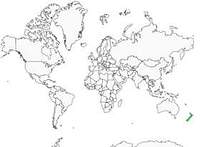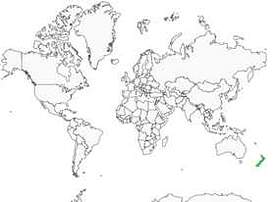Huia
Heteralocha acutirostris - Huia dimorphe
Identification
Extinct species. The Huia, an endemic species of New Zealand's North Island, was last observed in 1907. It was the largest of the Callaeidae family, slightly larger than the New Zealand Saddleback. Its plumage was a glossy black with metallic green and blue-violet reflections, especially on the head. It is the only endemic species with white tips on its long tail feathers for 2 to 3 cm. Both sexes had cream-ivory base of the beak, oval fleshy wattles of 24 mm/16 mm folded under the beak, which were yellowish to vivid orange, and grey-bluish tarsi. Sexual dimorphism was very prominent in the shape and size of the beak. Male: strong beak, 5.4-6 cm slightly curved downwards. Female: thin beak, 8.5-14 cm, clearly bent downward. The difference was so stark that some thought it was two distinct species. This is the most extreme dimorphism among birds in terms of the beak. Immatures were a brown-black with a sandy-white visible in the tail feathers, the white wattles colored with age.
Subspecific information monotypic species
Foreign names
- Huia dimorphe,
- Huia,
- uía,
- Huialappenvogel,
- huja,
- Huia,
- Huia,
- huia,
- Huia,
- laločník huia,
- laločník ostrozobý,
- Huia,
- huia,
- kurobród różnodzioby,
- Гуйя,
- ホオダレムクドリ,
- 镰嘴垂耳鸦,
- huia,
- 黃嘴垂耳鴉1907滅絕,
Voice song and call
Different melodious and flute-like songs, audible from a distance of 400 m. It was apparently the first bird to sing at dawn. The singing differed according to the gender. Duets took place between the couple - they would call out to each other and reply in turn. During these calls, they pointed their beaks to the sky at a 45° angle.
Habitat
Primary forests composed of indigenous species, including the Huia.
Behaviour character trait
Male Huia used their beak to dig and search through decomposing wood. Females had longer beaks, which could reach into galleries of wood not yet in decomposition, this sexual dimorphism might have avoided competitive feeding between the two. Scientists are not agreed on this explanation, as it does not exist in any other species. Buller noted that transfer of food went from male to female but never the other way around. He also described one pair of Huia cooperating to hunt a weta, with the male tearing off the exterior of a young green tree and the female attempting to retrieve the orthoptera. If unsuccessful, the female would retreat and allow the male to widen the hole. It was not skittish and would not flee from humans.
Flight
Poor flyers, the Huia rarely flew above the trees, instead moving through the forest on the ground, or jumping from branch to branch. They were capable of making leaps of up to 6 metres.
Dietfeeding habits
It mainly fed on wood-boring insects and their larvae, huhu (Prionoplus reticularis), Wetas (Hemideina. Sp, Deinacrida. sp) mantids, butterflies, and spiders, collected from rotting woods, bark, lichens, mosses, ferns and the ground. They also ate native forest fruits and plant matter.
Reproduction nesting
A captive pair of Huia observed by Buller was jumping from branch to branch, shaking their tails and rubbing their beaks while emitting a low trill on contact. He thought it was a courtship parade. The males were feeding the females during the courtship parade. The breeding season lasted 5 months from October to February. The laying period was from September to October. The couples were monogamous, only the female incubated. The laying was 2-4 eggs. The incubation period is unknown. The immatures remained in the family group, fed by both adults, for at least three months. An unconfirmed observation reported a nest in a rotten "maitai" tree, at a height of 4.50 m from the ground containing four eggs that had been laid in the decomposing wood.
Geographic range
Some birds must certainly have survived until the 1920s, confined to the mountain range stretching from White Island to Bay of Plenty in the southeast of the North Island. The species had already become rare before the arrival of Europeans. Bone remains prior to the arrival of the Maoris indicate it was common in the North Island, but absent from the South Island.
Threats - protection
IUCN conservation status
concern
in the Wild
threatened
evaluated
Predation by introduced mammals and, to a lesser extent, hunting are probably the causes of the species' extinction. Destruction of the environment to make way for agriculture in the 1800s would have had a minor impact on the extinction of the species. For the Maori, traditionally wearing the tail feathers was a sign of status. These same feathers became fashionable in Britain in the early 1900s. Collectors and natural history museums have bought many preserved specimens and tail feathers. The Austrian naturalist Andreas Reischek bought 212 pairs between 1877 and 1889. The New Zealand naturalist Buller reported that 11 Maori hunters captured 646 within one month in 1863. Thousands of Huia were exported abroad. Protection measures adopted in the 1890s were not applied. Two male birds kept in the London Zoo in the 1880s died in captivity. A couple captured in 1893 for reintroduction on the island of Little Barrier were acquired by Walter Buller and apparently sent to Baron Walter Rothschild in England.
Sources of information
- IOC World Bird List (v15.1), Gill, F and D Donsker (Eds). 2025-12-07.
- Handbook of Australian, New Zealand and Antarctic birds, 1: ratites to ducks., Marchant, S.; Higgins, P. J.
- Handbook of the birds of the world Vol.14, josep del Hoyo
- Know your New Zealand Birds, Lynnette Moon
- The hand guide to the birds of New Zealand, Robertson Hugh et Heather Barrie
- ARKive, Christopher Parsons
- Avibase, Lepage Denis
- Conservation-comments-NZ,
Other sources of interest
 Specification sheet created on
01/08/2023 by Yann Cambon
Specification sheet created on
01/08/2023 by Yann CambonTranslation by AI Oiseaux.net
© 1996-2025 Oiseaux.net
- Accipitriformes
- Aegotheliformes
- Anseriformes
- Apodiformes
- Apterygiformes
- Bucerotiformes
- Caprimulgiformes
- Cariamiformes
- Casuariiformes
- Charadriiformes
- Ciconiiformes
- Coliiformes
- Columbiformes
- Coraciiformes
- Cuculiformes
- Eurypygiformes
- Falconiformes
- Galliformes
- Gaviiformes
- Gruiformes
- Leptosomiformes
- Mesitornithiformes
- Musophagiformes
- Nyctibiiformes
- Opisthocomiformes
- Otidiformes
- Passeriformes
- Pelecaniformes
- Phaethontiformes
- Phoenicopteriformes
- Piciformes
- Podargiformes
- Podicipediformes
- Procellariiformes
- Psittaciformes
- Pterocliformes
- Rheiformes
- Sphenisciformes
- Steatornithiformes
- Strigiformes
- Struthioniformes
- Suliformes
- Tinamiformes
- Trogoniformes



